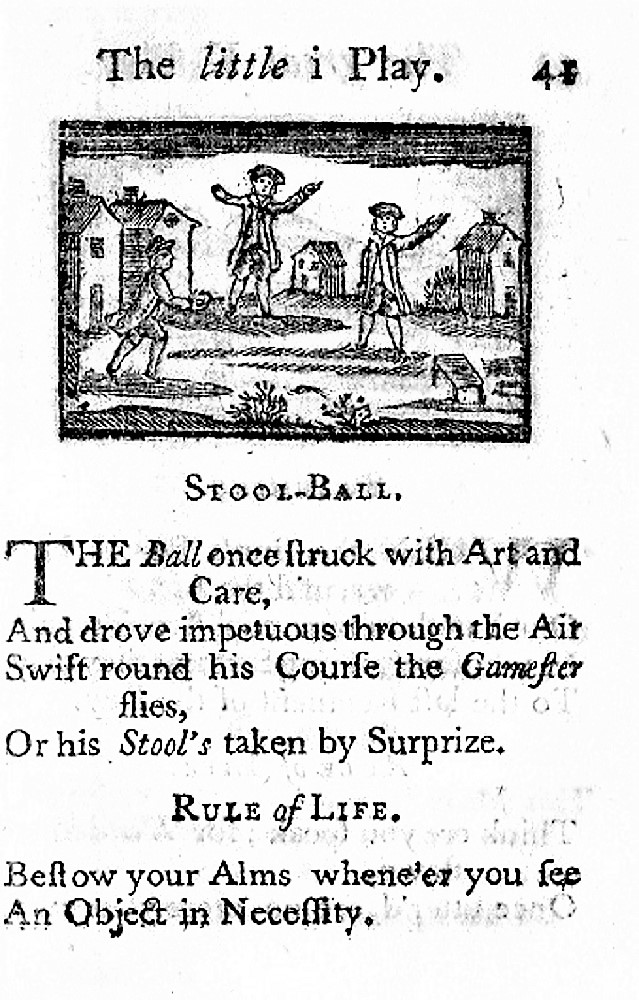1787 Stool Ball A Little Pretty Pocket-Book, Intended for the Instruction and Amusement of Little Master Tommy, and Pretty Miss Poll” by Isaiah Thomas, Worcester, Massachusetts
Reportedly it was the first recorded bat-and-ball-type game known to have been played in North America (at Plymouth in 1621 at Christmastime much to the chagrin of Governor Bradford). In this game, the pitcher tries to hit a stool or stump with the ball, while the batter tries to defend the target using bare hands or a bat.When they began sailing across the 17C Atlantic to the New World, British American colonials brought with them memories of games played for centuries in England & on the European continent. Games brought people together. Many of these indoor & outdoor games morphed & changed a bit in the colonies. Some disappeared, but many others remain today in one form or another.
The game of Stool Ball is referred to by name as early as 1450. Nearly all early references describe it as a game played during Easter celebrations, typically as a courtship pastime rather than a competitive game. In the 15C there were complaints of the game being played in churchyards after Sunday service. The game consists of placing milking stools on the ground and defending them with a hand. Some stools were also suspended from trees.
Down in a vale on a summer's day
All the lads and lasses met to be merry,
A match for kisses at stool-ball to play,
And for cakes, and ale, and cider and perry.
Song from 1694
The game's associations with romance remained strong into the modern period. Written by William Shakespeare and playwright John Fletcher, the comedy, The Two Noble Kinsmen used the phrase "playing stool ball" as a euphemism for sexual behavior. Stool Ball makes an appearance in the dictionary of Samuel Johnson, where it is defined as a game played by driving a ball from stool to stool. Stool Ball seems to have been one of the earliest sports in which women participated.
Reportedly it was the first recorded bat-and-ball-type game known to have been played in North America (at Plymouth in 1621 at Christmastime much to the chagrin of Governor Bradford). In this game, the pitcher tries to hit a stool or stump with the ball, while the batter tries to defend the target using bare hands or a bat.When they began sailing across the 17C Atlantic to the New World, British American colonials brought with them memories of games played for centuries in England & on the European continent. Games brought people together. Many of these indoor & outdoor games morphed & changed a bit in the colonies. Some disappeared, but many others remain today in one form or another.
The game of Stool Ball is referred to by name as early as 1450. Nearly all early references describe it as a game played during Easter celebrations, typically as a courtship pastime rather than a competitive game. In the 15C there were complaints of the game being played in churchyards after Sunday service. The game consists of placing milking stools on the ground and defending them with a hand. Some stools were also suspended from trees.
Down in a vale on a summer's day
All the lads and lasses met to be merry,
A match for kisses at stool-ball to play,
And for cakes, and ale, and cider and perry.
Song from 1694
The game's associations with romance remained strong into the modern period. Written by William Shakespeare and playwright John Fletcher, the comedy, The Two Noble Kinsmen used the phrase "playing stool ball" as a euphemism for sexual behavior. Stool Ball makes an appearance in the dictionary of Samuel Johnson, where it is defined as a game played by driving a ball from stool to stool. Stool Ball seems to have been one of the earliest sports in which women participated.
In this game, the pitcher tries to hit a stool or stump with the ball, while the batter tries to defend the target using bare hands or a bat. Stool ball was played by women and men together as a sort of springtime ritual, played at Easter time. In many stool ball games, tansy-cakes were the traditional winners' prize. Tansy-cakes were a traditional Easter time food. It is difficult to find the rules of stool ball. In some versions of the game, there was no bat, and bare hands were used instead. Other versions had no base running, just a single stool or stump base that the batter was expected to defend. However, bats and running the bases were included in some versions, too.
By the 19C, some rules had been established in England. Like cricket it had 11 players-a-side who played in much the same positions. The wickets were a square board of wood on top of a wooden post or stake. The batter defended the board with a bat shaped rather like an elongated table tennis bat and made of willow. The wickets were 16 yards apart. The bowler could only bowl underarm to try to hit the wicket. The batsman had to hit the ball and score runs by running between wickets.
